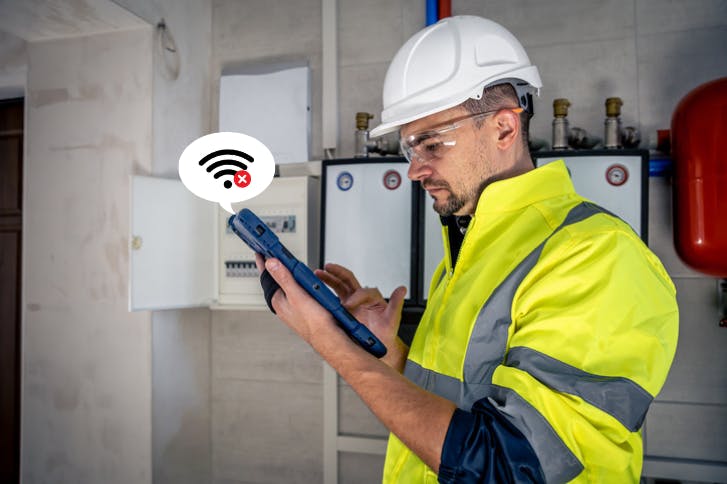AI has set field operations on a new course. Before, human intelligence was responsible for identifying defects, which often led to errors and inefficiencies. Now, AI and computer vision can detect the smallest of defects with remarkable accuracy and speed.
It’s a game changer that’s revamped our expectations of quality control. Thanks to advanced AI tools and comprehensive training data, this process is now fully automated, and many sectors such as telecommunications or energy are leveraging it in their field operations.
However, on-field operators often find themselves working in remote areas, basements, or other challenging environments where internet connectivity can be unreliable or non-existent.
This calls for a versatile AI solution that can function offline to assist on-field operators. Without it, the consequences can be severe. Defects will be missed. Performance will be impacted. And safety will be compromised.
In this blog, we will explore the critical need for offline capabilities in AI solutions for field-operations, especially in the context of quality control. We will also discuss how Deepomatic’s capabilities are evolving to provide robust offline functionality to help technicians meet the sky-high standards of quality control in all environments.

The Importance of Offline Capabilities in AI-Powered Quality Control
Technicians often work in remote areas or environments with no internet access. This can prevent them from accessing real-time quality control automation, leading to potential errors and inefficiencies.
Therefore, an offline solution is not a need - it is a must. Without validation on site, errors or oversights can go undetected, which can trigger a series of repercussions:
- Increased Rework: Technicians may need to revisit the site to correct errors, resulting in additional labor costs and delays.
- Decreased Efficiency: Undetected issues can cause disruptions in workflow, reducing overall operational efficiency.
- Compromised Safety: Critical safety issues may go unnoticed, posing risks to both technicians and end-users.
- Customer Dissatisfaction: Incomplete or faulty work can lead to customer complaints and loss of trust.
- Higher Operational Costs: Repeated visits and extended project timelines can increase overall operational expenses.
- Lower Quality Standards: Persistent undetected errors can degrade the overall quality of service or product.
As highlighted, the absence of an offline solution will only promise an erosion of quality control standards that will drain resources and impact safety. Deepomatic’s AI systems are being developed to provide offline functionality.
With these upcoming capabilities, technicians will receive immediate insights and validation, facilitating quicker decision-making and reducing the likelihood of errors.
For example, technicians can use these solutions to detect defects and validate repairs on the spot, without needing to wait for internet connectivity. This not only boosts their productivity but also ensures that higher standards of work quality are maintained.
As Deepomatic continues to develop and deploy these features, technicians can look forward to more reliable, efficient, and accurate tools to support their work in various challenging environments.

Challenges of Implementing Offline AI Solutions
Up to now it’s been apparent how crucial offline AI solutions are in field operations. However, this is a case of easier said than done because of the number of obstacles that need to be overcome.
One of the main challenges is the requirement for high computational power. Machine learning models, particularly complex ones, require significant processing power to function effectively.
This involves making the AI models smaller and more suited to the hardware capabilities of mobile or handheld devices, especially when one cannot expect all target mobile devices in the fleet to be the latest high end and most powerful ones. These adjustments often require making small trade-offs in accuracy to improve the user experience and ensure real-time performance.
Then we have another obstacle – the memory limitations of hardware in remote or harsh environments. Field operators often use mobile or handheld devices that may not have sufficient memory to support numerous AI models.
Therefore, models need to be combined to use less memory, which generally also correlates with faster performance. It is thus a considerable challenge to make sure these devices operate complex AI models efficiently while maintaining high performance and usability.

Challenges Faced by Generative AI Models in Offline Settings
The main problem with generative AI is that it is particularly demanding in offline settings. These large generative AI algorithms require extensive computational power and memory, often needing several gigabytes to operate, making them impractical for smartphones and offline environments. Tasks such as natural language processing and image generation are particularly resource-intensive.
This is problematic because many technicians often work in areas where unreliable or unavailable network access makes it difficult to conduct quality control automation efficiently in the field.
Although generative AI models can be downsized to function on a phone, this reduction leads to decreased performance. In contrast, deep neural networks specialized on the task at hand are more easily optimized for use on local hardware such as tablets and mobile devices.
Leveraging Discriminative AI Models for Offline Use
The challenges of generative AI for an offline solution are both apparent and significant. Overcoming this requires Deepomatic to use discriminative AI models, which are optimized for offline use.
Unlike generative AI, discriminative ones are designed to classify and identify patterns in data rather than generate new data. This approach requires less computational power and can be more easily integrated into field devices with limited hardware capabilities.
For more on how traditional deep learning assists on-field technicians, read our case study Discriminative AI vs. Generative AI: What’s Best for Quality Control Automation in the Field?
With Deepomatic’s offline solution, the discriminative AI models are tailored to provide high performance without the need for extensive computational resources. Our focus on offline optimization enables its AI solutions to perform efficiently and accurately, even when connectivity and hardware are limited.
This provides on-field technicians with a unique robust offline solution that allows them to achieve maximized quality control, irrespective of their connectivity or hardware capabilities.

Maximized Quality Control Hinges on Offline AI Solutions
AI has become an indispensable tool to maintain exceptional quality control standards in on-field operations. However, technicians will inevitably work in areas where network connections are limited. Therefore, the integration of offline AI applications, as developed by AI researchers, is fundamental to support field workers in their daily jobs.
Currently, Deepomatic is creating an offline AI solution that overcomes challenges related to connectivity. Technicians will be able to benefit from real-time defect detection and quality control, even in remote or connectivity-challenged environments.






